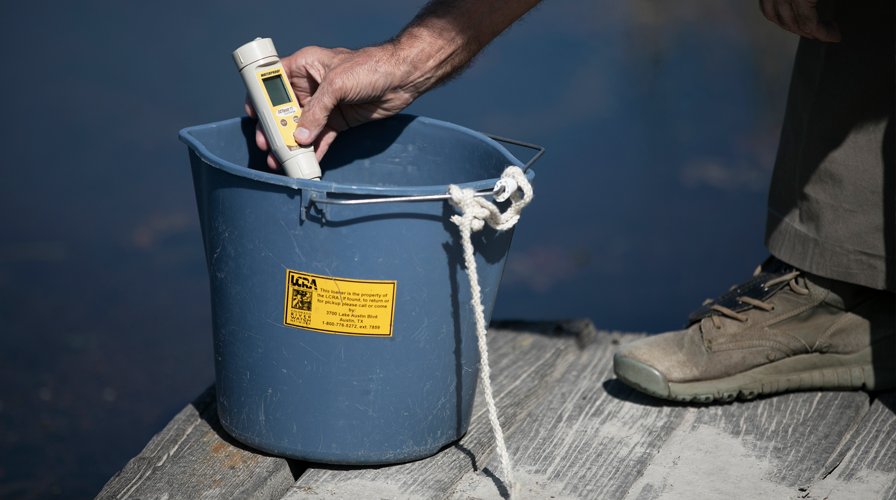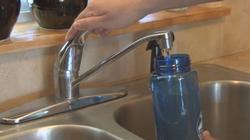Water Quality Indicators
Volunteers test for several key water quality indicators. The resulting water quality data provide baseline information, helps identify trends or changes in water quality, and aids investigations into problems such as nonpoint-source pollution and nutrient enrichment.
Dissolved oxygen (DO)
The DO test measures the amount of oxygen dissolved in the water. Oxygen is essential for both plants and animals, but high levels in water can be harmful to fish and other aquatic organisms. Nonpoint-source pollution can decrease the amount of dissolved oxygen in water, which can be harmful to fish and other aquatic organisms. The decomposition of leaf litter, grass clippings, sewage and runoff from feedlots decreases DO readings. Dissolved oxygen is measured in milligrams per liter (mg/L). Expected levels: 4.0 to 12.0 mg/L
Water temperature
Aquatic organisms are dependent on certain temperature ranges for optimal health. Temperature affects many other parameters in water, including dissolved oxygen, types of plants and animals present and the susceptibility of organisms to parasites, pollution and disease. Causes of temperature change in water include weather conditions, shade and discharges from urban sources or groundwater inflows. Temperature is measured in degrees Celsius (°C). Seasonal trends: May to October: 22 to 35°C, November to April: 2 to 27°C
pH
A pH test measures the alkalinity or acidity of water. A pH of 7 is neutral, below 7 is acidic and above 7 is basic or alkaline. Acid rain, from auto exhaust or other pollutants, causes a drop in the pH. Pollution from accidental spills, agricultural runoff and sewer overflows can also change the pH. Buffering capacity is water’s ability to resist changes in pH, and is critical to the survival of aquatic life. The limestone soils of Central Texas act to neutralize these acids and often result in a more basic pH. While young fish and insect larvae are sensitive to a low pH (acid), extreme values on either end of the scale can be lethal to most organisms. Expected levels: 6.5 to 9.0

Testing Your Water
Domestic wells should be tested annually for the presence of coliform bacteria, as an indicator of pathogens. More frequent testing is suggested if visual changes in the water quality are noticed or if unexplained health changes occur. The table below provides a schedule and list of analyses for testing. When water tests positive for pathogens, owners may choose to use shock chlorination to disinfect the well casing and household plumbing. This may not eliminate the contamination if it is found in the aquifer water itself. In that case, the owner should seek an alternate source of water or install a home water disinfection system.
Water Testing
Before purchasing or installing a water treatment system, test your water at the tap. Be aware that water testing is not an easy or inexpensive step. Laboratory fees for water quality analysis vary greatly from one parameter to another. In 2004, for example, testing for hardness, TDS, and pH may cost about $50. Testing for lead or nitrate may cost about $25. However, testing for all possible individual pollutants can cost more than $2,000 per sample.
If you suspect that your house plumbing may be contaminating your water, test your water at the tap for those contaminants that may be present. Carefully choose the list of contaminants to be tested with the assistance of a qualified water quality expert. See the table of water problems and suggested tests, and review the national drinking water standards.
Laboratory Test Results
Have the tests results explained to you by a qualified analyst or water quality expert. For example, terms mean that a pollutant could not be detected below a certain value or detection limit. We values should be listed in the laboratory report and they should always be lower than maximum contaminant level.
Determine which parameters have values above drinking water standards and which parameter you would like to lower in order to improve water quality. (Information below on health effects and likely sources is from the Agency for Toxic Substances and Disease Registry, its parent organization, Centers for Disease Control and Prevention, and the Environmental Protection Agency.)

Best Water Test Kits
Water is always at risk of being contaminated with harmful bacteria. Whether you use it for laundry, drinking, bathing, or swimming, there is always the risk of coming in contact with contaminants. Therefore, water quality is a concern for many people.
Did you know that you can test the quality of the water you use? There are water testing kits that allow you to check whether your water is good or not. There are various types of kits as well, and they come at multiple prices to let people use healthier water.
What Do Water Kits Test For?
Water test kits have one goal – to detect the contaminants in your water, so you can take the proper measures to ensure your safety. Water test kits detect many contaminants, such as iron, lead, nitrate, nitrite, alkalinity, pesticides, hardness, bacteria, and many others. Home water test kits could detect these and not only in different water sources, allowing you to live a healthy life with safe and contaminant-free water.
The Comfort of Your Home
What is great about home water test kits is that you can use them at home, and you don’t need to hire an expert to complete such a test. All you have to do is fill up some recipients with water and use the test kit you purchased. In various ways, the tests will show you if the water you use is safe or not. Thus, they help you take measures in case the water is bad.
No Contamination
Drinking water that is contaminated by chemicals could have a serious impact on you and your health. If the test is negative, then you know you have to take some safety measures to stop the contamination and start drinking clean water again.

Different Ways to Test Water Quality Professionally
Biological Indicators
Biological monitoring metrics is the simplest and least expensive method
Insects such as the mayfly, stone-fly and caddisfly. Generally, the greater the number found, the better the water quality. Organisations offer guidance on developing a monitoring program and identifying members of these and other aquatic insect orders.
Bivalve molluscs are largely used as bio-indicators to monitor the health of aquatic environments in both fresh water and the marine environments. A typical project today they are used worldwide
Macro-invertebrates (such as the aquatic earthworm) is a bio-monitoring tool that is used to measure river health. We are a simpler scoring system that can be used by anyone, even school children.
Test Strips
Test strips for various water quality parameters are available, such as pH, chlorine, etc. Here you dip a little paper strip with graduated colours into your water sample and match it with a colour on a printed list, to determine the level of the parameter
How You Can Reduce Exposure to Lead
Run your water to flush out lead.
If the water has not been used for several hours, run each tap for 30 seconds to 2 minutes or until it becomes colder before drinking or cooking. This flushes water which may contain lead from the pipes. This can reduce lead in water levels up to 90%.
Use cold, fresh water for cooking and preparing baby formula.
Do not cook with or drink water from the hot water tap; lead dissolves more easily into hot water. Do not use water from the hot water tap to make baby formula.
Test your child for lead.
Ask your physician to find out how to have your child tested for lead. A blood lead level test is the only way to know if your child is being exposed to lead.
Check whether it reduces lead – not all filters do. Be sure to maintain and replace a filter device in accordance with the manufacturer’s instructions to protect water quality. Learn more about how to choose a water filter on the treatment page.
Particles containing lead from solder or household plumbing can become trapped in your faucet aerator. Regularly cleaning every few months will remove these particles and reduce your exposure to lead.